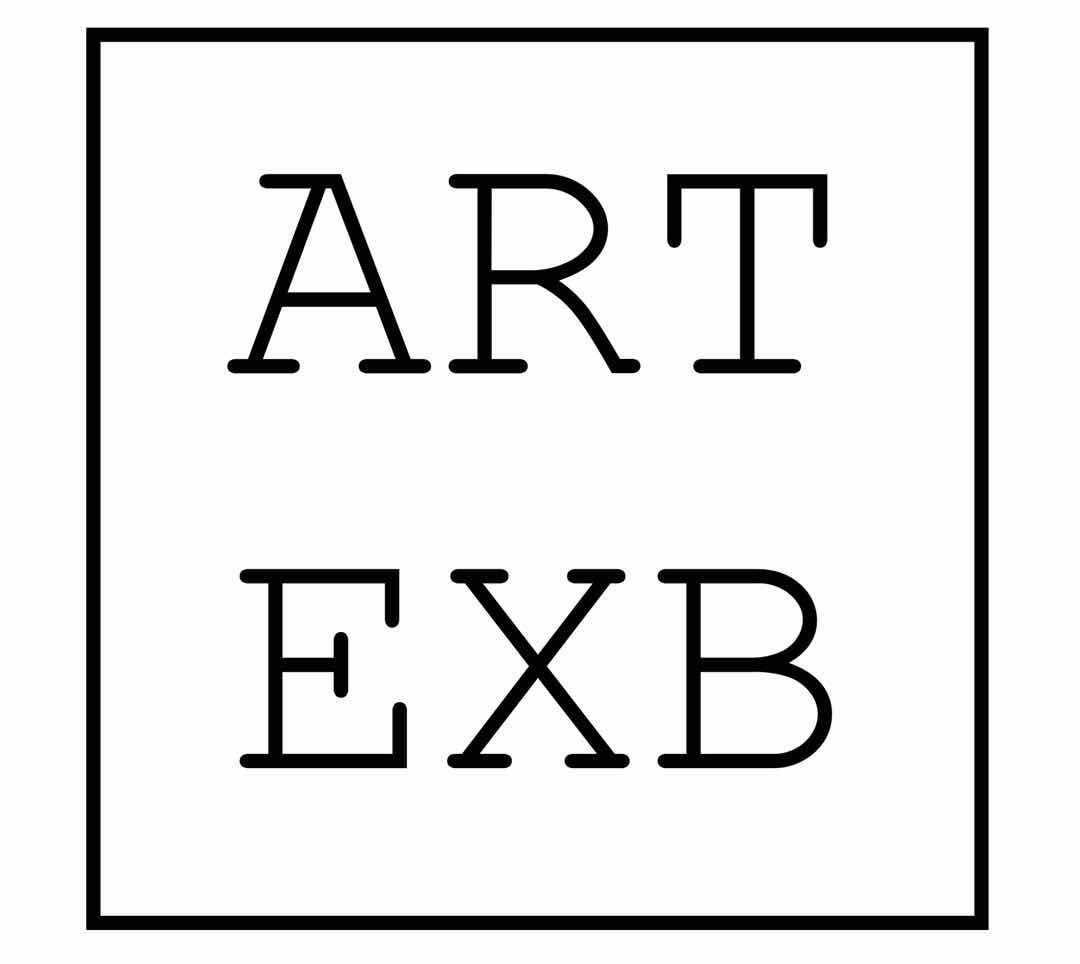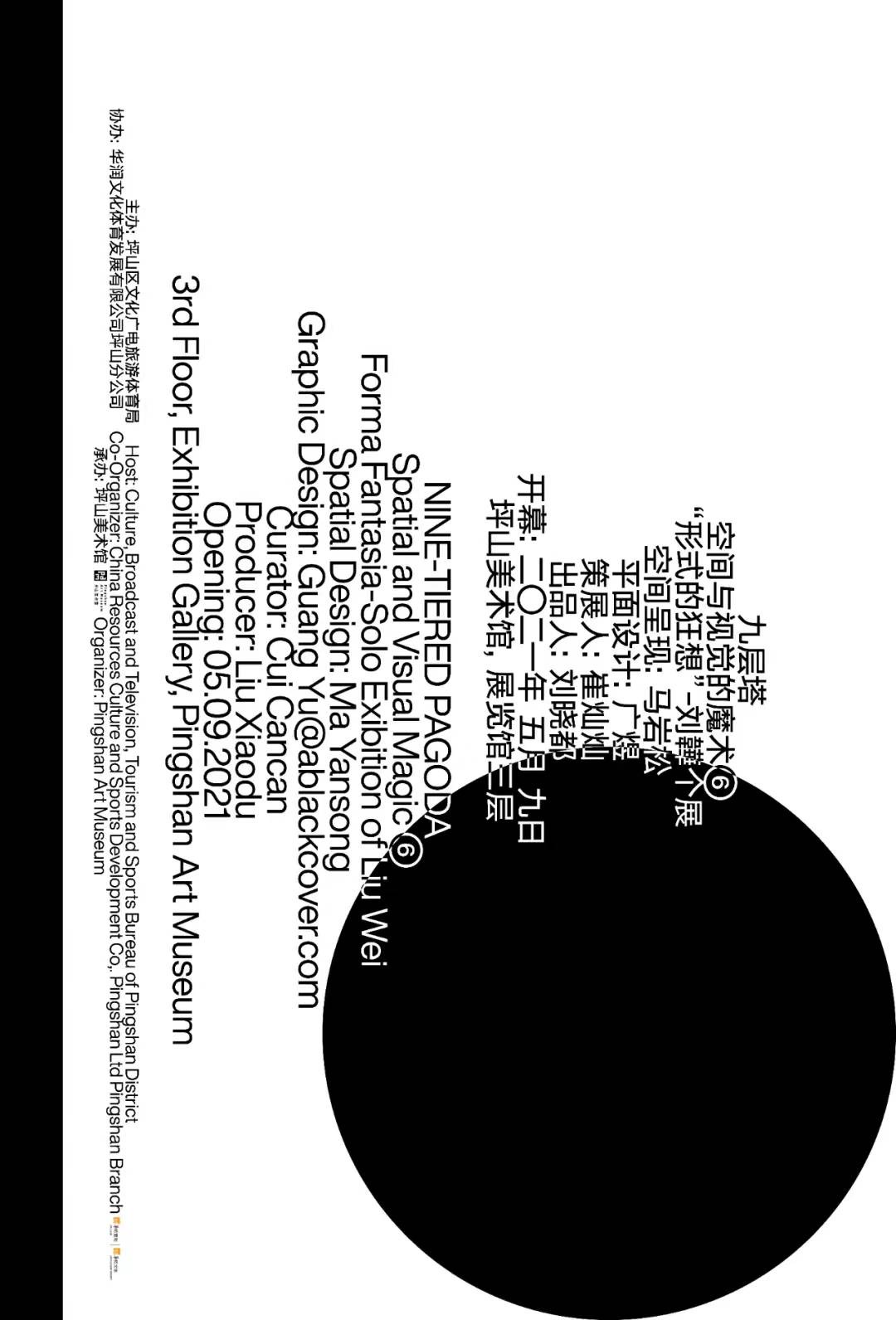“九层塔:空间与视觉的魔术” 是一次跨界行动,是中国从未有过的展览方向和形式。它将邀请9位/组艺术家提供作品,作为展览的基础素材,同时邀请9位建筑师,9位设计师,组成九个临时团队。艺术家、建筑师、设计师三方联名合作,没有 “主次” 和 “中心”,只是分工与协作,最终形成9个全新类型的展览。
空间和设计是决定展览的核心元素,也是对展览和作品的再创作和再生产,它决定了观众看到什么,怎么看,看的次序和节奏。空间和设计,在这里不再是为展览服务,而是独立自主的体验,给予展览无数的变量和可能。
一直以来,我们缺乏一种高质量的跨界,它们不是流俗于明星和网红效应,迎合一种快餐式的出圈,就是自说自话,拘泥于专业壁垒。“九层塔” 倡导的跨界方式,创造了一个艺术、建筑和设计的连接点,一个全新的交叉学科,它既是三个专业间的实际需求,有益协作,又保留了各自的专长和优势,分工得当。
作为中国古代建筑,“塔” 有着一种特殊的结构,它的每一层讲述着不同的故事。这些故事和空间、设计,紧密围绕成一个彼此叠加的整体,成为展览的外在形象和精神内核。
“九层塔:空间与视觉的魔术” 由策展人崔灿灿和建筑师刘晓都共同在2020年发起,它是一个混合了思想、方法、工具的实践项目,也是对跨领域工作的兴趣班,拓展彼此方向的攻关小组。
“九层塔” 的出现,饱含着创造一个全新领域和事业的雄心,旨在发明一种新的合作方式和展览观念,重塑这个时代的感知体验。
“形式的狂想” 刘韡个展
作为九层塔的第六个项目,“形式的狂想” 像是一部狂想曲,激发想象力的形式实验室,亦或是一幕孕育着无限力量的舞台剧。展览以艺术家刘韡的几何形装置为基础,邀请建筑师马岩松进行空间的呈现,平面设计师广煜进行海报等视觉系统的创作。
作为新一代文化代表的中坚力量,刘韡、马岩松、广煜的工作,植根于中国发展进程中的一个重要阶段,深受新世纪中国社会特有的变动和起伏影响——城市和人文景观的快速变迁。在这个时期,现代主义中的形式不再作为形式而存在,形式成了快速变幻与未来想象的媒介。“狂想” 召唤人们走向形式的指引,走向无限的联想和 “所有”。这里的 “所有” 可能是万事万物的运动法则,这里的 “明暗光影” 可能是时间的起源或变幻的光阴,“上扬的线条” 可能预示着飞升的雄心,“圆” 是起点,也是循环的终点。 和九层塔其它项目相比,这个展览有了新的合作方式,艺术家刘韡并没提供 “完整” 的作品,而是提供了一些作品的材料和散落的部件。这些几何形体的圆、块面、曲线,带着打磨的痕迹,像是立体主义绘画的笔触,或是等待被摆放的抽象形体,最终以什么形式展出,由建筑师决定。 建筑师马岩松将这些 “未命名” 的作品,放置在一个 “陌生” 的空间,类似于宇宙的黑洞。这让作品呈现出与过往展览中截然不同的气质和观感。时间停滞,并且沉浮,沉默无言的 “静物”,释放了巨大的张力。挤压的空间,看似狭小,却具引力,一道光像是预示着 “太空舱” 外的浩瀚,“力” 在这里获得了重量和样貌。马岩松用去形式化的方式,挑战着 “形式的狂想”。 历史上许多时刻或是古老的仪式,在斗转的时空中,总会被染上天启般的色彩。“形式的狂想” 在这里暗示的是亘古不变的法则,是历史长河和昨夜琐事里,都暗含的光影与走势。事物中的动与静,开与合,垂直与堕落,飞扬与低陷,可能源自立体派或是未来主义某幅画作里的静物,可能预示着春天枝木的崩裂,可能为了铭记19世纪午夜后的一场暴雨,或是太空漫游里的一块石碑,几万年间弹指一挥的波澜壮阔。 在设计师广煜的海报中,形式给了我这样的想象,信息排成塔的样子,线条是地平线的开始,圆悬于高处,海上古塔升明月。“形式的狂想” 亦是 “九层塔” 的狂想,它希望人们从束缚中出走,用广阔的感知去想象没有边界的未来。我们狂想,在希望之春和失望之冬中战斗,直至万物寂静,悄无声息。 策展人 崔灿灿 Nine-Tiered Pagoda: Spatial and Visual Magic, as a cross-disciplinary event, represents an unprecedented direction and form of exhibition in China. Nine (groups of) artists will provide their works as the basis material for the exhibition. Besides, nine architects and nine designers will also join to form nine temporary teams, hence the cooperation among artists, architects and designers. There is no ‘priority’ or ‘center’ in the exhibition, only division of labor and collaboration, presenting nine individual exhibitions of a brand-new type. As the core determinant for the exhibition, space and design are also a kind of re-creation of the exhibition and the work; They determine the content and how the audience see the exhibition, as well as the sequence and pace. Space and design, no longer in the service of the exhibition, provide an independent and autonomous experience for the audience, granting the exhibition a myriad of variables and possibilities. There has always been a lack of quality cross-disciplinary exhibitions, which are neither a fast food product preached by celebrities and online influencers nor a highbrow art confined to professional barriers. The cross-disciplinary advocated by Nine-Tiered Pagoda creates a nexus joining art, architecture and design together with a new cross-discipline, which reflects the practical needs and collaboration of the three professions, while it also retains the expertise and strengths of each with a proper division of labor. As an ancient Chinese architecture, ‘Pagoda’ has a special structure, with each tier telling a different story. These stories, spaces, and designs are closely intertwined with each other into a superimposed whole, formulating the external image and spiritual core of the exhibition. Nine-Tiered Pagoda: Spatial and Visual Magic, launched by curator Cui Cancan and architect Liu Xiaodu in 2020, is a hands-on project that mixes ideas, methodologies and tools. It’s not only a workshop for cross-disciplinary art, but also a platform for artists, architects and designers to cooperate and expand their development realms together. The advent of Nine-Tiered Pagoda represents the ambition to create an entirely new field, with an aim to invent a new way of collaboration and to create a fresh exhibition concept that can reshape the perceptual experience of our times. Forma Fantasia – Solo Exhibition of Liu Wei As the sixth project of “Nine-Tiered Pagoda”, “Forma Fantasia” is like a rhapsody, a laboratory of forms that inspires imagination, or a stage play that breeds infinite power. The exhibition is based on the geometric installations created by the artist Liu Wei, with the architect Ma Yansong designing the space, and the graphic designer Guang Yu in charge of posters and other visual designs. As the backbone of the new generation of cultural representatives, the works of Liu Wei, Ma Yansong, and Guang Yu are rooted in an important stage of China’s development and has been deeply affected by unique changes and vicissitudes of the Chinese society in the new century, that is, the rapid changes of the urban and cultural landscape. In this period, the form in ancient modernism no longer exists as a form. Instead, it has become a medium of rapid change and future imagination. “Fantasia” calls people to follow the guidance of “form”, to pursue the infinite association and “wholism”. The “wholism” here may be the law of motion of everything, while the “light and shadow” may represent the origin of time or its change. The “rising line” will herald the ambition of soaring, while the “circle” is the starting point and the next loop. Compared with other projects of “Nine-Tiered Pagoda”, this exhibition presents a new way of cooperation. Artist Liu Wei doesn’t provide a “complete” work, but some materials and scattered parts instead. The circles, blocks, and curves of these geometric shapes, with traces of polish, are like the brushstrokes of a Cubist painting, or the abstract shapes waiting to be placed. The way they will finally be exhibited depends on the architect. Architect Ma Yansong places these “unnamed” works in a “unfamiliar” space, similar to a black hole in the universe. This grants the works a completely different temperament, if look and feel from previous exhibitions. Time stagnates, while still going through ups and downs, just like the silent “still life” releasing a huge tension. The squeezed space, seemingly small, but is in fact gravitational. A beam of light foreshadows the vastness outside the “space capsule”, where “force” has gained its weight and tangible form. Via the de-formalized approach, Ma Yansong challenges the “Forma Fantasia”. Many moments or ancient rituals in history, in the ever-changing time and space, will always be presented with sacred meanings. “Forma Fantasia” here implies an eternal law, the light and shadow, the dynamic and trend in the long river of history and in all the triviality of the past. The dynamic and static, openness and intensity, verticality and falling, flying and sinking in these illustrated objects may originate from still life in the Cubist or Futuristic paintings, which may indicate the breakage of branches and trees in spring, a midnight torrential rain in the 19th century, a stone tablet lost in a space odyssey, or the magnificent ripples deriving from tens of thousands of years in just a blink of eyes. In the poster created by Designer Guang Yu, the form itself conveys such an imagination, where all information is arranged in a tower. The line represents the horizon and the circle hangs high like a moon rising over the ancient tower erecting against the sky. “Forma Fantasia” is also the fantasy of the “Nine-Tiered Pagoda”. It hopes that people can get out of the shackles and imagine a future without boundaries with broad perception. We fantasize and fight in the spring of hope and the winter of despair, until everything goes silent. Cui Cancan, Curator

